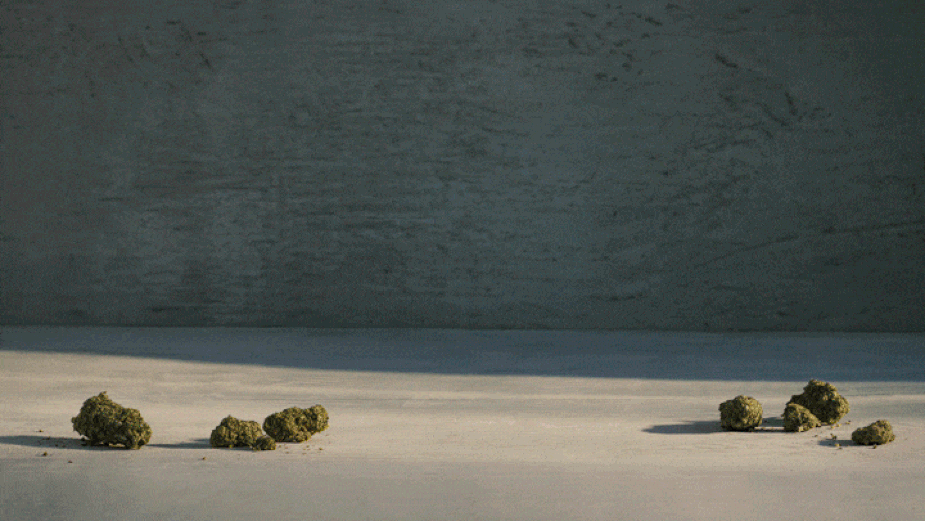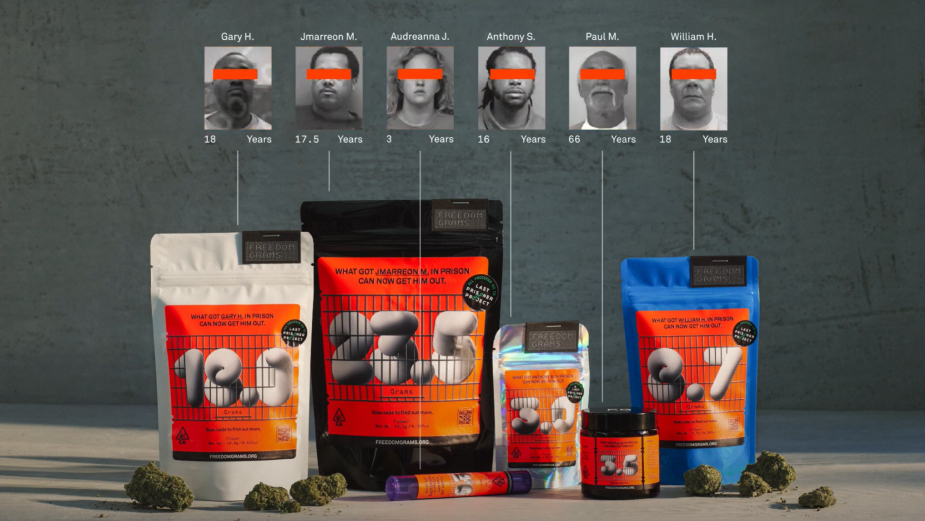
How These ‘Freedom Grams’ Fight for the Release of Cannabis Prisoners

Freedom Grams is a project that was borne out of the desire to form a meaningful connection between cannabis consumers and cannabis prisoners. For cannabis users living in states and nations where the substance has been legalised, there can be a disconnect in awareness - and especially in cannabis branding - between those who enjoy legally purchasing cannabis and the reality that many people are still imprisoned for having possessed those same quantities prior to decriminalisation.
Working with cannabis production platform AROYA, scientific tech company METER Group and cannabis retailer GABY Inc., Serviceplan launched the ‘Freedom Grams’ brand with packages of 0.3, 3.5, 8.7, 18.0, and 23.5 grams - the exact amounts for which others in the U.S. are currently incarcerated.
Through AR elements, custom-designed typography and other design goodies in the brand’s packaging, the Freedom Grams help tell the stories of incarcerated people and raise awareness of the cause, as well as the charitable organisation ‘Last Prisoner Project’. The brand is also ‘open-source’ - meaning that other cannabis retailers and brands can get involved and use the ‘Freedom Grams’ labels, name and designs to further spread the important message and resources.
To discuss how the innovative campaign came about, the creation of an “open-source brand” and the hard-hitting stories of people incarcerated for cannabis possession, LBB’s Ben Conway spoke with Shruthi Subramanian, junior copywriter at Serviceplan Innovation.
LBB> When and how did you get involved with this project? Have you worked with AROYA or Last Prisoner Project before?
Shruthi> I first got involved in the project about a year ago when I was an intern from Miami Ad School, here in the Serviceplan Innovation team. One of my first tasks as an intern was to research the whole issue and zero in on possible stories. What’s really cool about this idea is that it also came from previous interns from my school. Shoutout to Anastasiia Cherniavska, Changkyu Ku, and Reinier Wortman!
AROYA is a sister company of the METER Group. You may know them through previous Serviceplan Group projects ‘Meltdown Flags’ and ‘Made in Fukushima’. The team has been working with them for many years now.
LBB> Was there a brief from AROYA? What was that like?
Shruthi> AROYA, like METER, is a sensor company, but focused on cannabis cultivation. And like METER, they process a lot of data. What they wanted to do was explore data around cannabis to do something cool. And in this process, the insight about criminalisation was brought up - which snowballed into the campaign that it is today.
LBB> How long was the process in total? Were you rushing to get this ready for 4/20?
Shruthi> Almost two years, I think. Yes, of course, launching on this special day was very important to us, because it’s a great opportunity to get the conversation started and remind everyone that someone is still in prison for the same thing that they were celebrating.

LBB> Where did you find the inspiration/insights for the various weights of product for this campaign [0.3, 3.5, 8.7, 18.0, and 23.5 grams]?
Shruthi> These are the exact amounts for which five individuals are still in prison. Together with researchers, we dug into public databases of different states while cross-checking local news articles and press releases from justice departments. We also had support from Last Prisoner Project in this task. These are only five of over 40,000. We went with these numbers because on top of being in grams, these are very unusual amounts of cannabis for US-based consumers.
LBB> Who worked on the website and packaging design? As well as the generative typography? What was that process like? What features were vital to be included?
Shruthi> The website was developed by Daniel Kuhnlein, packaging design by Moby Digg, and type design by Michael Clasen. It was a long process with many, many iterations and explorations. It was vital for the typography to tell the story of freedom. We had bits and pieces everywhere: the grid based on prison bars, the numbers breaking out, a simple headline to break down the whole mechanic. And over the months, it came together rather beautifully.
We wanted to create something iconic because this isn’t some one-off, limited-edition line of products. The whole pack has a haptic feel to it, so you can really feel the prison bars, and the numbers winding in and out. We made the test prints in Hamburg with the founders of Habibi production.
The copy focuses on the person and the contradiction that this person is in prison while the name of the brand is more subtly incorporated into a custom matchbook. The matchbook is stapled to the side of the pack to give it a rough look. All these details were thought through along with Moby Digg after consulting with the GABY Inc. compliance team in the U.S.
LBB> How was the AR aspect of the campaign concepted and subsequently produced?
Shruthi> It was really important for us to create a connection between the consumer and the person in prison. AR fit this task because this led to the isolation of the number and the grid. So, we take away the product and really just focus on exploration of data.
LBB> Did you have to contact the people who were imprisoned for these amounts of cannabis to get permission to use their stories? If so, what has been their reaction to this campaign?
Shruthi> While we have anonymised them, we still wanted to get in touch with them or a family member to support them. We were also able to find a couple of connections through Last Prisoner Project. The responses that we received from some of the family members have been so appreciative. We’ve had the opportunity to work with people who were previously incarcerated. Helping people feel seen - this for me was our greatest success.

LBB> Freedom Grams is an “open-source brand” - can you explain what this means and how more brands and people can get involved in this campaign?
Shruthi> What this means is that Freedom Grams is only a label, one that any grower or retailer can use on their own products to collect funds to help free cannabis prisoners. Anyone can become a partner by reaching out via partners@freedomgrams.org and anyone can submit a story to feature by reaching out via cases@freedomgrams.org.
This is an initiative for the cannabis industry started by members of the industry AROYA along with distributor GABY Inc. Thanks to their network, we’re about to announce several more supporters and are in talks with many more.
LBB> Cannabis marketing can be quite a foreign concept to those of us in countries that haven’t legalised it - how would you describe the advertising culture of the cannabis market and how does this campaign compare to and differ from what people expect?
Shruthi> Anything to do with cannabis is considered provocative and you just know you have everyone’s attention, but there is also scrutiny. During the whole process, we had to navigate a lot of rules and regulations on what can or cannot be shown or said on the pack.
It’s great to see a lot of conscious and ethical cannabis products that acknowledge the need to give back while recognising that the taboo still exists. What makes Freedom Grams different is that we wanted for this pack to hold a mirror to each individual, so they can see themselves in cannabis prisoners who once held the exact same amount. There is also the actual amounts; as I said before, these are not usual numbers that you would expect to see in a dispensary anywhere.

LBB> What was the hardest challenge you faced on this campaign? And how did you overcome it?
Shruthi> It was really hard reading these stories of people. Up to 66 years of a sentence, convicted at 18, and then there’s the statistic that incarceration actually decreases life expectancy by two times the whole sentence. I think we all had moments when the data really got to us. And I’m not quite sure if we did “overcome” this. We just pushed through to tell their stories, the best we could, to gather more support for them.
More on the execution front, we were pretty clear on many of the elements and ideas we wanted to include, but we had to streamline them. This, of course, meant that some of them didn’t make it to the final board. We were only able to overcome the fear of missing out some of the elements through rounds of feedback and feedback from a fresh pair of eyes.
LBB> Anything else you would like to add?
Shruthi> Just that from concept to craft, we left no stone unturned. I was and still am in constant awe, as a young creative just starting out, to have worked with people who have so much passion for what they do. That stuff is contagious.













